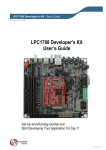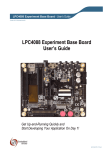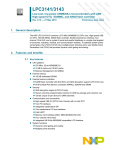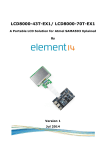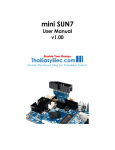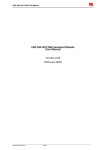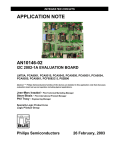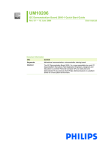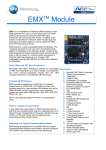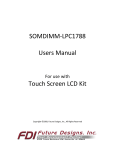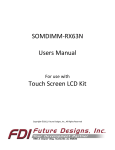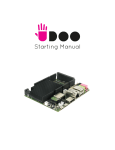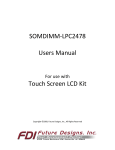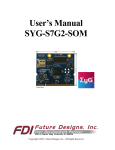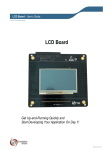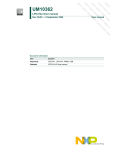Download MA00013 touch screen LCD kit users manual R3p2
Transcript
Touch Screen LCD Kit Users Manual CARRIER & LCDCARRIER 5.7” or LCDCARRIER 3‐5 or LCDCARRIER 4WQ Copyright ©2011, Future Designs, Inc., All Rights Reserved Table of Contents 1. Introduction ___________________________________________________________________________________ 1 2. Functional Description __________________________________________________________________________ 1 3. ESD Warning __________________________________________________________________________________ 2 4. Requirements _________________________________________________________________________________ 2 5. Board Layout __________________________________________________________________________________ 3 CARRIER BOARD__________________________________________________________________________________ 3 LCDCARRIER (5.7” QVGA Shown) ____________________________________________________________________ 5 LCDCARRIER 4WQ ________________________________________________________________________________ 6 6. Functional Block Diagram ________________________________________________________________________ 7 7. I/O Connector Descriptions _______________________________________________________________________ 8 CARRIER ________________________________________________________________________________________ 8 DC Power Input – P5 ____________________________________________________________________________ 8 Alternate Power Input – J8 _______________________________________________________________________ 8 USB Device – P6 ________________________________________________________________________________ 8 USB Host – P1 _________________________________________________________________________________ 9 Ethernet – J5 __________________________________________________________________________________ 9 CAN/RS485 – P3_______________________________________________________________________________ 10 RS232 – P4 ___________________________________________________________________________________ 10 External I2C – J6 _______________________________________________________________________________ 11 External I2S Audio – J9 (Rev 1 PCB only) ____________________________________________________________ 11 External I2S Stereo Audio – J9 & J10 (Rev 2 PCB and later) _____________________________________________ 11 External I2S Stereo Audio – J9 & J10 (Rev 3 PCB and later) _____________________________________________ 12 8. On Board Functions ____________________________________________________________________________ 13 CARRIER _______________________________________________________________________________________ 13 User I/O Expander – U8 _________________________________________________________________________ 13 Real Time Clock – U10 __________________________________________________________________________ 13 Accelerometer – U9 ____________________________________________________________________________ 14 Temperature Sensor – U11 ______________________________________________________________________ 14 Optional WiFi Module – U6 (Rev 2 PCB and later) ____________________________________________________ 14 LCDCARRIER ____________________________________________________________________________________ 15 Touch Screen Controller TSC2046 – U2 (Not supported on LCDCARRIER 3‐5) ______________________________ 15 Backlight Generator LCDCARRIER 5.7”: LT1932 ‐ U1, LCDCARRIER 3‐5: LT3591 – U4 ________________________ 15 CARRIER Expansion Connector Descriptions ________________________________________________________ 16 ii J2 ____________________________________________________________________________________________ 16 J3 ____________________________________________________________________________________________ 17 J4 ____________________________________________________________________________________________ 18 9. CARRIER Jumper Details ________________________________________________________________________ 19 JP1 Real Time Clock Interrupt Enable ________________________________________________________________ 19 JP2 3‐Axis Accelerometer Interrupt Enable ___________________________________________________________ 19 JP3 RS232 DCE<>DTE Configuration (Rev 2 PCB and later) _______________________________________________ 20 JP4 – JP7 RS485 or CAN Mode Select for P3 (Rev 2 PCB and later) _________________________________________ 21 JP8 UART RCV Data Disable – only used for ISP support on DIMM modules (Rev 2 PCB and later) ________________ 21 JP9 Optional WiFi Module Interrupt Enable (Rev 2 PCB and later) _________________________________________ 21 JP10 Optional WiFi Module Chip Enable (Rev 2 PCB and later) ____________________________________________ 21 10. SOMDIMM Module Installation __________________________________________________________________ 22 11. Mechanical Details ____________________________________________________________________________ 23 CARRIER _______________________________________________________________________________________ 23 LCDCARRIER ____________________________________________________________________________________ 24 12. Software ____________________________________________________________________________________ 25 13. Schematics ___________________________________________________________________________________ 25 14. Table of Figures _______________________________________________________________________________ 25 Information in this document is provided solely to enable the use of Future Designs products. FDI assumes no liability whatsoever, including infringement of any patent or copyright. FDI reserves the right to make changes to these specifications at any time, without notice. No part of this document may be reproduced or transmitted in any form or by any means, electronic or mechanical, for any purpose, without the express written permission of Future Designs, Inc. 2702 Triana Blvd, Huntsville, AL 35805 NOTE: The inclusion of vendor software products in this kit does not imply an endorsement of the product by Future Designs, Inc. 2011 Future Designs, Inc. All rights reserved. ® uEZ is a registered trademark of Future Designs, Inc. Microsoft, MS‐DOS, Windows, Windows XP, Microsoft Word are registered trademarks of Microsoft Corporation. Other brand names are trademarks or registered trademarks of their respective owners. FDI PN: MA00013 Revision: 3.2, 10/10/2011 11:11:00 AM Printed in the United States of America iii 1. Introduction The DK‐TS‐KIT is optimized to save development time in typical embedded control applications. Its modular format uses a base carrier board, a core CPU DIMM board and an LCD carrier board. The base carrier board includes expansion connectors for added flexibility and a range of configurations. This manual supports the following DK‐TS‐KIT part numbers: DK‐57TS‐LPC2478 5.7” QVGA Touch Screen LCD Kit for the LPC2478, Toshiba PN: LTA057A344F or equivalent DK‐57TS‐LPC3250 5.7” QVGA Touch Screen LCD Kit for the LPC3250, Toshiba PN: LTA057A344F or equivalent DK‐57VTS‐LPC2478 5.7” VGA Touch Screen LCD Kit for the LPC2478, Okaya PN: RV640480T‐5X7WP or equivalent DK‐35TS‐LPC2478 3.5” QVGA Touch Screen LCD Kit for the LPC2478, Okaya PN: RH320240T‐3X5WP‐A or equivalent DK‐57VTS‐LPC3250 5.7” VGA Touch Screen LCD Kit for the LPC3250, Okaya PN: RV640480T‐5X7WP or equivalent DK‐57VTS‐LPC1788 5.7” VGA Touch Screen LCD Kit for the LPC2478, Okaya PN: RV640480T‐5X7WP or equivalent DK‐43WQH‐1788 4.3” WQVGA Touch Screen LCD Kit for the LPC1788, Hitachi PN: TX11D06VM2APA 2. Functional Description CARRIER 200 pin SO‐DIMM Socket RS232 Serial Port (Male DB9) CAN Port (Male DB9) – alternate with RS485 RS485 Full Duplex (Male DB9) – alternate with CAN 10/100 Ethernet Connector Optional 802.11 b/g WiFi Module USB Type‐A Host Connector USB Mini‐B Device Connector LM75 Temperature Sensor 3‐axis Accelerometer Real‐time Clock with Super‐Cap Backup Four User Pushbuttons Four User LEDs Speaker External I2C Connector (Optional) Reset Button LCDCARRIER 5.7” Active TFT QVGA LCD (320x240) mounted to LCDCARRIER 5.7 Board or 5.7” Active TFT VGA LCD (640x480) mounted to LCDCARRIER 3‐5 Board or 5.7” Active TFT QVGA LCD (320x240) mounted to LCDCARRIER 3‐5 Board or 3.5” Active TFT QVGA LCD (320x240) mounted to LCDCARRIER 3‐5 Board or 4.3” Active TFT WQVGA LCD (480x272) mounted to LCDCARRIER 4WQ Board or 4.7” Active TFT WQVGA LCD (480x272) mounted to LCDCARRIER 4WQ Board Touch Screen LED Backlight 1 3. ESD Warning The DK‐TS‐KIT is shipped in a protective anti‐static package. The Kit must not be subjected to high electrostatic potentials. Damage may occur to the Kit that will not be covered under warranty. General practice for working with static sensitive devices should be followed when working with the DK‐TS‐KIT. 4. Requirements The DK‐TS‐KIT comes with all necessary cables to begin development right away. The Kit includes a Type‐A to Mini‐B USB cable, a CAT5 Ethernet cable, a 5.0VDC, 2A, AC Wall Adapter and either the Segger JTAG Debugger or a USB‐ICP‐ LPC2K mini ISP programmer. A PC will be required to install the development tools to program the SOMDIMMs. The DK‐ TS‐KIT will be powered using the 5VDC AC Wall Adapter included in the kit and may be plugged into any standard 110VAC wall socket. An available Ethernet network will be needed for using the Ethernet connection on the CARRIER and a free USB port will be needed for using the available USB connections. CAUTION: DO NOT POWER THE DK‐TS‐KIT WITH ANY OTHER POWER THAN 5VDC. USE OF ANY OTHER ADAPTER MAY DAMAGE THE BOARD AND VOID THE WARRANTY. 2 5. Board Layout CARRIER BOARD Figure 1 – CARRIER Top Side (Rev 4 Shown) 3 Figure 2 – CARRIER Bottom Side (Rev 4 Shown) 4 LCDCARRIER (5.7” QVGA Shown) Figure 3 – LCDCARRIER Top Side Note: The LCDCARRIER 3‐5 Board is identical from the top side but also supports optional 3.5” or 5.7” LCDs from several vendors. 5 LCDCARRIER 4WQ Figure 4 – LCDCARRIER Top Side 6 6. Functional Block Diagram MiniJTAG ISP SDRAM (x32) I/O 10/ 100 PHY EXP SOMDIMM-LPC2478 LPC2478 ARM7TDMI-S text Based Microprocessor LCD uSD Slot 200 PIN DIMM EDGE FINGER 3-AXIS ACC CAN USB HOST EXPANSION CONNECTORS CARRIER USB DEVICE LCD SIGNALS POWER INPUT I2C EXPANSION SIGNALS I2S EXPANSION 200 PIN DIMM SOCKET TEMP SENSOR RS232 REAL TIME CLOCK USER I/O ETHERNET PB LED PB LED PB LED PB LED 50 PIN LCD INTERFACE CONNECTOR 50 PIN LCD INTERFACE CONNECTOR LCDCARRIER 5.7" QVGA 320x240 LCD TOUCHSCREEN Figure 5 – DK‐TS‐KIT System Block Diagram (LPC2478 Shown) 7 7. I/O Connector Descriptions CARRIER DC Power Input – P5 The Touch Screen Kit utilizes a 5VDC 2.3A Power Supply. The connector is 2.1mm with center positive. Pin Number Description 1 5VDC, +/‐ 10%, 2.0A (min) 2 Power Supply Ground Alternate Power Input – J8 The CARRIER Board includes an optional alternate power input connector, J8. This connector provides an optional input connection for the on‐board DC‐DC regulator. Pin Number Description 1 5VDC, +/‐ 10%, 2.0A (min) 2 Power Supply Ground USB Device – P6 The CARRIER Board includes one USB Device Interface allowing the unit to be connected to a USB Host, such as a PC. Through this connection, the CARRIER represents a peripheral to the USB Host. The operational mode of the port is dependent on the software utilized (i.e. Mass Storage or Human‐Interface). The CARRIER Board may also be powered via the USB Device connector. Care must be taken to not overload the USB Host since 500mA is the maximum current allowable via USB. The LCD Backlight may be disabled or the brightness dimmed to facilitate this USB Powered mode. When D1 is on it indicates a “good link” on the USB Device port. When D2 is on it indicates that the USB Device port is enabled. D2 will also blink during re‐enumeration. Pin Number Description 1 USB 5V 2 D‐ 3 D+ 4 NC 5 Signal Ground 8 USB Host – P1 The CARRIER Board includes one USB Host Port allowing the unit to interface to various USB peripherals such as a USB Flash Drive (Thumb Drive). The operational mode of this port is dependent on the software utilized (i.e. driver support) Please refer to the specific details of the processor module being utilized for support of the USB Host function. D3 indicates VBUS power is good for the USB Host port. Pin Number Description 1 USB VBus 2 D‐ 3 D+ 4 Signal Ground Ethernet – J5 The CARRIER Board includes one 10/100 Ethernet Port to interface to a local area network via CAT5 cable. Please refer to the specific details of the processor module being utilized for support of the Ethernet Port function. Pin Number Description 1 Tx+ 2 3.3V 3 Tx‐ 4 Rx+ 5 3.3V 6 Rx‐ 7 No Connect 8 Signal Ground 9 CAN/RS485 – P3 The CARRIER Board includes one Male DB9 Interface Connector that supports either CAN or RS485 (Rev 2 and later) depending on the configuration of jumpers JP4 – JP7. The CAN interface utilizes an NXP TJA1040TD high speed transceiver IC to provide fully ISO 11898 standard interface at up to 1MBaud. The TJA1040 allows up to 110 nodes and very low electromagnetic emissions. Note: Rev 1 PCB only supports CAN on P3 Please refer to the specific details of the processor module being utilized for support of the CAN interface function. RS485 Mode Pin Number CAN Mode (Rev 2 and later only) 1 2 3 4 5 6 7 8 9 No Connect CANL Signal Ground Signal Ground Signal Ground Signal Ground CANH No Connect 5V No Connect 485_RDB‐ 485_TDA+ Signal Ground Signal Ground Signal Ground 485_RDA+ 485_TDB‐ No Connect RS232 – P4 The CARRIER Board includes one RS232 Serial Port Connector. This connector is a Male DB9 configured as either DCE or DTE (Rev 2 and later only) depending on the configuration of jumper block JP3. The interface includes optional RTS & CTS handshaking signals that are brought to test points that the user may connect as needed (see page 5 of the schematic). Please verify proper connectivity of this connector to the proper TXD<>RXD orientation. TXD is an OUTPUT from the CARRIER Board and RXD is an INPUT to the CARRIER Board. Note: Rev 1 PCB only supports DCE on P4 Please refer to the specific details of the processor module being utilized for support of the RS232 Serial Port function. DCE Mode DTE Mode Pin Number (Rev 2 and later only) 1 2 3 4 5 6 7 8 9 No Connect TXD (Output) RXD (Input) No Connect Signal Ground No Connect (OPT) RTS (OPT) CTS No Connect 10 No Connect RXD (Input) TXD (Output) No Connect Signal Ground No Connect (OPT) RTS (OPT) CTS No Connect External I2C – J6 The CARRIER board provides an external I2C connector for users to connect to the I2C bus of the microprocessor. CARRIER Rev 1 Pin Number 1 2 3 4 Description 3.3V Signal Ground GPIO67_ESCL GPIO66_ESDA Pin Number 1 2 3 4 5 6 7 8 9 Description 5V 5V 3.3V 3.3V GPIO75_SCL Signal Ground GPIO74_SDA GPIO116 GPIO117 CARRIER Rev 2 and later Please refer to the specific details of the processor module for connectivity details. External I2S Audio – J9 (Rev 1 PCB only) The Rev 1 CARRIER board provides an external I2S Audio Expansion Connector. Please refer to the specific details of the processor module for connectivity details. Description 3.3V GPIO51_I2SRX_CLK 5.0V GPIO54_I2STX_CLK Signal Ground Pin 1 3 5 7 9 Pin 2 4 6 8 10 Description Signal Ground GPIO52_I2SRX_WS GPIO53_I2SRX_SDA GPIO55_I2STX_WS GPIO56_I2STX_SDA External I2S Stereo Audio – J9 & J10 (Rev 2 PCB and later) The I2S audio circuitry is not currently loaded and thus not supported at this time. 11 External I2S Stereo Audio – J9 & J10 (Rev 3 PCB and later) The I2S audio circuitry is loaded and supports input and output of audio. J9 is microphone input and J10 in headphone output. LCDCARRIER J4 – Male 25x2 Header for Ribbon Cable connection to CARRIER Board (Default) J3 – Female 25x2 Right Angle Socket for Board‐to‐Board Straight Connection to CARRIER Board (Optional) Pin 1 3 5 7 9 11 13 15 17 19 21 23 25 27 29 31 33 35 37 39 41 43 45 47 49 Signal Name GND LCD_TS_XL LCDVD2 LCD_R2 LCD_R4 GND SCL (1) LCD_G0 LCD_G2 LCD_G4 GND NC LCDVD18 LCD_B2 LCD_B4 GND LCDPWR LCD_VSYNC LCD_HSYN GND 3.3V EXT_SCK EXT_MISO LCD_TS_XR EXT_IRQ SOMDIMM Connection Signal Ground GPIO72 GPIO127 GPIO31 GPIO33 Signal Ground I2C Clock GPIO88 GPIO90 GPIO92 Signal Ground No connect GPIO45 GPIO94 GPIO96 Signal Ground GPIO25 GPIO28 GPIO30 Signal Ground 3.3V Power Supply GPIO62 GPIO64 GPIO70 GPIO69 Pin 2 4 6 8 10 12 14 16 18 20 22 24 26 28 30 32 34 36 38 40 42 44 46 48 50 Signal Name GND LCD_TS_YD LCD_R1 LCD_R3 LCD_R5 GND SDA (1) LCD_G1 LCD_G3 LCD_G5 GND NC LCD_B1 LCD_B3 LCD_B5 GND LCDLE LCDENAB LCDDCLK KEY 5.0V EXT_MOSI LCD_TS_YU LCD_SPI_CS LED_BR SOMDIMM Connection Signal Ground GPIO73 GPIO128 GPIO32 GPIO34 Signal Ground I2C Data GPIO89 GPIO91 GPIO93 Signal Ground No connect GPIO46 GPIO95 GPIO97 Signal Ground GPIO26 GPIO29 GPIO27 No connect 5.0V Power Supply GPIO65 GPIO71 GPIO36 (2) GPIO86 (1) No Connect on LCDCARRIER 5.7” Rev 2 assembly (2) Rev 2 CARRIER Only Note: GPIOxx references the pin number of the DIMM socket, ex: GPIO45 is connected to pin 45 of the DIMM socket. 12 8. On Board Functions CARRIER User I/O Expander – U8 User Input/Output functions are provided by an NXP PCA9551. The PCA9551 LED blinker blinks LEDs in I2C‐bus and SMBus applications where it is necessary to limit bus traffic or free up the I2C‐bus master's CPU timer. The uniqueness of this device is the internal oscillator with two programmable blink rates. The PCA9551 LED blinker requires only the initial set‐up command to program BLINK RATE 1 and BLINK RATE 2 (i.e., the frequency and duty cycle) for each individual output. From then on, only one command from the bus master is required to turn each individual open‐drain output on, off, or to cycle at BLINK RATE 1 or BLINK RATE 2. Any bits not used for controlling the LEDs can be used for General Purpose parallel Input/Output (GPIO) expansion. The active LOW hardware reset pin (RESET) and Power‐On Reset (POR) initializes the registers to their default state, all zeroes, causing the bits to be set HIGH (LED off). Pushbuttons There are four pushbuttons for general purpose user input; SW1, SW2, SW3, & SW4. These pushbuttons are connected to the PCA9551 signals LED0 – LED3 respectively. LEDs There are four LEDs for program status output to the user; LED1, LED2, LED3, LED4. These LEDs are connected to the PCA9551 signals LED4 – LED7 respectively. PCA9551 Device I2C Address = 0xC0 For detailed information, please refer to the specific data sheet for this device available from the manufacturer. Real Time Clock – U10 The CARRIER Board provides a low power Real Time Clock IC, an NXP PCF8563. This device is backed up by a 0.33F Super‐Cap. At a typical standby current of 250 nA, the Super‐Cap may provide backup power for up to 660 hours to the PCF8563 (at room temperature). The PCF8563 contains sixteen 8‐bit registers with an auto‐ incrementing address register, an on‐chip 32.768 kHz oscillator with one integrated capacitor, a frequency divider which provides the source clock for the Real‐Time Clock/calendar (RTC), a programmable clock output, a timer, an alarm, a voltage‐low detector and a 400 kHz I2C‐bus interface. In some kits the internal RTC on the DIMM module will be the default, such as the SOMDIMM‐LPC1788, and U10 will not be used. PCF8563 Device I2C Address = 0xA2 For detailed information, please refer to the specific data sheet for this device available from the manufacturer. 13 Accelerometer – U9 The CARRIER Board provides a 3‐axis Digital Accelerometer from Bosch, BMA150. Offering many smart functional features, the BMA150 is aimed for consumer market applications. It allows measurement of accelerations in 3 perpendicular axes. An internal evaluation circuit converts the output of a three‐channel micromechanical acceleration sensing structure that works according to the differential capacitance principle. Rev 4 and later us a Freescale MMA7455 accelerometer. BMA150 Device I2C Address = 0x70 MMA7455 Device I2C Address = 0x1D For detailed information, please refer to the specific data sheet for this device available from the manufacturer. Temperature Sensor – U11 The CARRIER Board provides a Digital Temperature sensor from NXP, LM75A. The LM75A uses the on‐chip band gap sensor to measure the device temperature with the resolution of 0.125 °C and stores the 11‐bit 2's complement digital data, resulted from 11‐bit A‐to‐D conversion, into the device Temp register. This Temp register can be read at any time by a controller on the I2C‐bus. Reading temperature data does not affect the conversion in progress during the read operation. The LM75A has an accuracy of ±2° C at ‐25° C to +100° C. LM75 Device I2C Address = 0x92 For detailed information, please refer to the specific data sheet for this device available from the manufacturer. Optional WiFi Module – U6 (Rev 2 PCB and later) The CARRIER Board optionally provides WiFi connectivity capability via the WiFi Module from Zero‐G, PN: ZG2100MC. The WiFi module is optional and may not be loaded on all kit configurations but can be purchased and added by the customer if desired. The WiFi module is connected to the SPI Bus and requires the use of an interrupt output for proper operation. The interrupt is shared with the Real Time Clock. For specific details on the WiFi module, please refer to the specific data sheet for this device available from the manufacturer. 14 LCDCARRIER Touch Screen Controller TSC2046 – U2 (Not supported on LCDCARRIER 35) The LCDCARRIER 5.7” Rev 2 includes an optional TSC2046 Touch Screen Controller IC for a SPI‐based touch screen application. This IC is not normally needed and is not loaded since the default touch screen interface is implemented by using discrete signals to the ARM® CPU. If the user desires to populate this device and use the SPI‐bus to facilitate the touch screen interface, refer to the schematic for details on the changes required. The LCDCARRIER 3‐5 Rev 1 does not include the optional TSC2046 Touch Screen Controller IC. For detailed information, please refer to the specific data sheet for this device available from the manufacturer. Backlight Generator LCDCARRIER 5.7”: LT1932 U1, LCDCARRIER 35: LT3591 – U4 The LCDCARRIER 5.7” utilizes a Linear Tech LT1932 constant current backlight driver IC to generate the required voltage and current for the LED backlight of the LCD Graphics Module. The LCDCARRIER 3‐5 utilizes a Linear Tech LT3591. The backlight circuit supports PWM brightness control via the ‘LED_BR’ signal that is connected to the microprocessor SOMDIMM. On the QVGA model, there is also an optional ‘ON/OFF’ control via the ‘LCDPWR’ signal. Refer to the microprocessor module user’s manual for specific connectivity of these signals. For detailed information, please refer to the specific data sheet for this device available from the manufacturer. 15 CARRIER Expansion Connector Descriptions J2 Pin Name Details Pin Name Details 1 GND GROUND 2 3V3 3.3V 3 GND GROUND 4 3V3 3.3V 5 RESET_IN RESET INPUT TO POR 6 RESET_OUT RESET OUTPUT FROM POR 7 3.3VA ADC VDD 8 VSSA ANALOG GROUND (ADC) 9 VREF ADC REFERENCE VOLTAGE 10 NC 11 GPIO57_TXD SERIAL TRANSMIST DATA 12 GPIO58_RXD SERIAL RECEIVE DATA 13 GPI059_USBH_VBUS USB HOST VBUS SENSE 14 GPIO60_USBD_UPLED USB DEVICE UP LED 15 GPI065_MOSI SPI MOSI 16 GPIO67_ESCL EXTERNAL I2C CLK 17 GPI069_TPIRQ TOUCH PANEL IRQ 18 GPIO71_AD0.1 ADC0 BIT 1 19 GPI073_AD0.3 ADC0 BIT 3 20 NC 21 GPI079 22 GPIO81 23 GPI083 24 GPIO85 25 GPI087_USBH_PPWR USB HOST PORT PWR 26 GPIO89_LCDVD11 LCD VIDEO BIT 11 27 GPI091_LCDVD13 LCD VIDEO BIT 13 28 GPIO93_LCDVD15 LCD VIDEO BIT 15 29 GPI0132 30 GPIO134 31 GPI0136 32 GPIO138 33 GPI0140 34 GPIO142 35 GPI0144 36 GPIO146 37 GPI0148 38 GPIO150 39 GPI0152 40 GPIO154 41 GPI0156 42 GPIO158 43 GPI0160 44 GPIO162 45 GPI0168 46 GPIO170 47 GPI0172 48 GPIO174 49 GPI0176 50 GPIO178 51 GPIO180 52 GPIO182 53 GPIO184 54 GPIO186 55 GPIO188 56 GPIO190 57 GPIO192 58 GPIO194 59 GPIO196 60 GPIO198 61 GND GROUND 62 3V3 3.3V 63 GND GROUND 64 3V3 3.3V Note: GPIOxx references the pin number of the DIMM socket, ex: GPIO45 is connected to pin 45 of the DIMM socket. 16 J3 Pin Name Details Pin Name Details 1 GND GROUND 2 3V3 3.3V 3 GND GROUND 4 3V3 3.3V 5 GPIO25_LCDPWR LCD PANEL POWER ENABLE 6 GPIO26_LCDLE LCD LINE END 7 GPIO27_LCDCLK LCD PANEL CLK 8 GPIO28_LCDFP LCD VERT SYNC 9 GPIO29_LCDENAB LCD DATA ENABLE OUTPUT 10 GPIO30_LCDLP LCD HORZ SYNC 11 GPIO31_LCDVD4 LCD VIDEO BIT 4 12 GPIO32_LCDVD5 LCD VIDEO BIT 5 13 GPIO33_LCDVD6 LCD VIDEO BIT 6 14 GPIO34_LCDVD7 LCD VIDEO BIT 7 2 15 GPIO53_I2SRX_SDA I S RECEIVE DATA 16 GPIO55_I2STX_WS I2S TRANSMIT WORD SELECT 17 GPIO61_USBD_CON USB DEVICE CONNECT CNTRL 18 GPIO63_TPCS SPI SLAVE SELECT 19 GPIO95_LCDVD21 LCD VIDEO BIT 21 20 GPIO97_LCDVD23 LCD VIDEO BIT 23 21 GPIO99_AD0.5 ADC0 BIT 5 22 NC 23 NC 24 NC 25 NC 26 NC 27 GPIO131 28 GPIO133 29 GPIO135 30 GPIO137 31 GPIO139 32 GPIO141 33 GPIO143 34 GPIO145 35 GPIO147 36 GPIO149 37 GPIO151 38 GPIO153 39 GPIO155 40 GPIO157 41 GPIO159 42 GPIO161 43 NC 44 NC 45 GPIO167 46 GPIO169 47 GPIO171 48 GPIO173 49 GPIO175 50 GPIO177 51 GPIO179 52 GPIO181 53 GPIO183 54 GPIO185 55 GPIO187 56 GPIO189 57 GPIO191 58 GPIO193 59 GPIO195 60 GPIO197 61 GND GROUND 62 3V3 3.3V 63 GND GROUND 64 3V3 3.3V Note: GPIOxx references the pin number of the DIMM socket, ex: GPIO45 is connected to pin 45 of the DIMM socket. 17 J4 Pin Name Details Pin Name Details 1 GND GROUND 2 3V3 3.3V 3 GND GROUND 4 3V3 3.3V 5 VBAT_IN RTC POWER SUPPLY 6 ALARM RTC ALARM 7 GPIO35 8 GPIO36 9 GPIO45_LCDVD18 LCD VIDEO BIT 18 10 GPIO46_LCDVD19 LCD VIDEO BIT 19 11 GPIO47_RD CAN1 RECEIVER INPUT 12 GPIO48_TD CAN1 TRANSMIT OUTPUT 13 GPIO49 14 GPIO50 15 GPIO51_I2SRX_CLK I2S RECEIVE CLK 16 GPIO52_I2SRX_WS I2S RECEIVE WORD SELECT 2 17 GPIO54_I2STX_CLK I S TRANSMIT CLK 18 GPIO56_I2STX_SDA I2S TRANSMIT DATA 19 GPIO62_SCK SPI CLK 20 GPIO64_MISO SPI MISO 21 GPIO66_ESDA EXTERNAL I2C DATA 22 GPIO68_USBH_OVC USB HOST OVER CURR 23 GPIO70_AD0.0 ADC0 BIT 0 24 GPIO72_AD0.2 ADC0 BIT 2 25 GPIO74_SDA I2C DATA 26 GPIO75_SCL I2C CLK 27 GPIO78_ACC_IRQ ACC IRQ 28 GPIO80_RTC_IRQ RTC IRQ 29 GPIO82 30 GPIO84 31 GPIO86_LED_BR LED BACKLIGHT 32 GPIO88_LCDVD10 LCD VIDEO BIT 10 33 GPIO90_LCDVD12 LCD VIDEO BIT 12 34 GPIO92_LCDVD14 LCD VIDEO BIT 14 35 GPIO94_LCDVD20 LCD VIDEO BIT 20 36 GPIO96_LCDVD22 LCD VIDEO BIT 22 37 GPIO98_USBD_PWRD USB DEVICE PORT PWR 38 GPIO100 39 NC 40 5V0 5.0V 41 NC 42 5V0 5.0V 43 NC 44 NC 45 GPIO116 46 GPIO118 47 GPIO120 48 GPIO122 49 GPIO124 50 GPIO126 51 GPIO128_LCDVD3 LCD VIDEO BIT 3 52 NC 53 GPIO115 54 GPIO117 55 GPIO119 56 GPIO121 57 GPIO123_MAT3.0 SPEAKER 58 GPIO125 59 GPIO127_LCDVD2 LCD VIDEO BIT 2 60 NC 61 GND GROUND 62 3V3 3.3V 63 GND GROUND 64 3V3 3.3V Note: GPIOxx references the pin number of the DIMM socket, ex: GPIO45 is connected to pin 45 of the DIMM socket. 18 9. CARRIER Jumper Details Figure 6 – Jumper Locations (Rev 2 PCB shown) JP1 Real Time Clock Interrupt Enable JP1 enables the interrupt output from the PCF8563 connected to GPIO80_RTC_IRQ. Refer to the specific details for the processor module to determine the location this signal is connected. The default for this jumper is shorted in artwork. To disable this function, the trace must be cut and a 2‐pin jumper installed to re‐enable. For functional information on the interrupt capability of the PCF8563, please refer to the data sheet for the Real Time Clock. JP2 3‐Axis Accelerometer Interrupt Enable JP2 enables the interrupt out from the 3‐Axis Accelerometer SMA150 connected to GPIO78_ACC_IRQ. Refer to the specific details for the processor module to determine the location this signal is connected. The default for this jumper is shorted in artwork. To disable this function, the trace must be cut and a 2‐pin jumper installed to re‐enable. For functional information on the interrupt capability of the SMA150, please refer to the data sheet for the Bosch Accelerometer. 19 JP3 RS232 DCE<>DTE Configuration (Rev 2 PCB and later) JP3 allows the on‐board RS232 port (P4) to be configured as either DCE or DTE by loading the jumpers either horizontally or vertically. DCE MODE DTE MODE JP3 JP3 4 3 2 1 4 3 2 1 Figure 7 – JP3 Illustration P4 PINOUT DETAILS Pin 1 2 3 4 5 6 7 8 9 DCE Mode NO CONNECT TXD OUTPUT RXD INPUT NO CONNECT SIGNAL GROUND NO CONNECT OPTIONAL RTS (DTE MODE ONLY) OPTIONAL CTS (DTE MODE ONLY) NO CONNECT DTE Mode NO CONNECT RXD INPUT TXD OUTPUT NO CONNECT SIGNAL GROUND NO CONNECT OPTIONAL RTS (DTE MODE ONLY) OPTIONAL CTS (DTE MODE ONLY) NO CONNECT 20 JP4 – JP7 RS485 or CAN Mode Select for P3 (Rev 2 PCB and later) JP4 through JP7 allow the selection of either CAN or RS485 functionality for the Male DB9 Connector P3. CAN MODE RS485 MODE CAN CAN RS485 RS485 MODE SELECT MODE SELECT Figure 8 – JP4 to JP7 Illustration JP8 UART RCV Data Disable – only used for ISP support on DIMM modules (Rev 2 PCB and later) JP8 allows the user to disable the UART receive data on the RS485 port (P3) for microprocessors that support ISP programming via the ISP header (J1) on the DIMM module. The default for this jumper is shorted in artwork. To disable this function, the trace must be cut and then a 2‐pin jumper installed to re‐enable data after ISP. Please refer to the specific documentation for the module/processor being utilized to determine if ISP is supported. JP9 Optional WiFi Module Interrupt Enable (Rev 2 PCB and later) JP9 enables the interrupt output from the WiFi Module ZG2100MC connected to GPIO80_RTC_IRQ. Refer to the specific details for the processor module to determine the location this signal is connected. The default for this jumper is shorted in artwork. To disable this function, the trace must be cut and a 2‐pin jumper installed to re‐enable. For functional information on the interrupt capability of the WiFi module ZG2100MC, please refer to the data sheet. JP10 Optional WiFi Module Chip Enable (Rev 2 PCB and later) JP10 enables the chip enable input to the WiFi Module ZG2100MC. The default for this jumper is shorted in artwork. To disable this function, the trace must be cut and a 2‐pin jumper installed to re‐enable. For functional information on the chip enable capability of the WiFi module ZG2100MC, please refer to the data sheet. 21 10. SOMDIMM Module Installation The SOMDIMM should be inserted into the DIMM Socket as shown below and then locked into place by pushing down to the Carrier Board. Ensure the SOMDIMM is inserted completely into the socket prior to locking. The socket utilized on the CARRIER Board is rated for a minimum of 25 insertions. Figure 9 – SOMDIMM Insertion 22 11. Mechanical Details CARRIER Below is an illustration of the mechanical dimensions of the CARRIER PCB Assy. Figure 10 – CARRIER Mechanical Details 23 LCDCARRIER Below is an illustration showing dimensions of the LCDCARRIER PCB Assy. Figure 11 – LCDCARRIER Mechanical Details 24 12. Software Please refer to the Software section of the SOMDIMM Users Manual included with your kit for details on the software. 13. Schematics Please visit the FDI website at: http://www.teamfdi.com/DK‐TS‐KIT 14. Table of Figures Figure 1 – CARRIER Top Side ................................................................................................................................................... 3 Figure 2 – CARRIER Bottom Side ............................................................................................................................................. 4 Figure 3 – LCDCARRIER Top Side ............................................................................................................................................. 5 Figure 4 – LCDCARRIER Top Side ............................................................................................................................................. 6 Figure 5 – DK‐TS‐KIT System Block Diagram (LPC2478 Shown) .............................................................................................. 7 Figure 6 – Jumper Locations ................................................................................................................................................. 19 Figure 7 – JP3 Illustration ...................................................................................................................................................... 20 Figure 8 – JP4 to JP7 Illustration ........................................................................................................................................... 21 Figure 9 – SOMDIMM Insertion ............................................................................................................................................ 22 Figure 10 – CARRIER Mechanical Details .............................................................................................................................. 23 Figure 11 – LCDCARRIER Mechanical Details ........................................................................................................................ 24 25






























